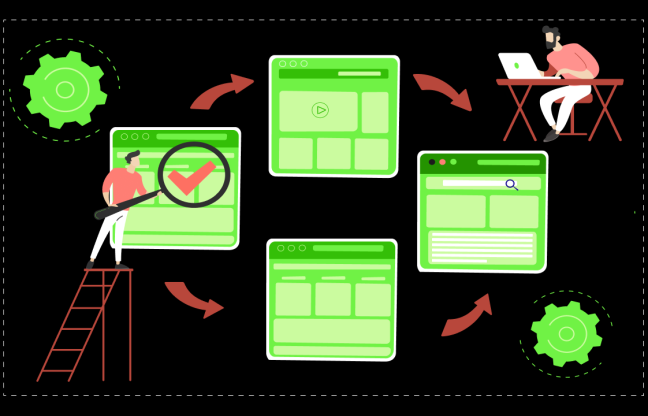Content writing is the process of researching, planning, writing, editing, and publishing content for the Internet. It can be a blog post, a script for a video, or a sales page. i.e. anything that is published online. SEO content writing is important because content helps you attract and retain customers.
If a webmaster neglects to competently fill up a web resource, sooner or later, worse ranking will occur. A carefully balanced article helps attract traffic by increasing conversion rates and making users take the target action. In this article, we will consider practical tips which you can apply to your content creation for SEO.
What is SEO Content?
SEO content is the articles that are placed on the pages of a website helping with its promotion to the top of the search engine rankings. These articles have to meet certain quantitative and qualitative characteristics and capture the interest of both search engines and the users, who visit a particular resource.
You have to take into account a number of features of the top-grade content, which include
- effective solution to a specific problem. The text should be of interest not only to search engines but also to users;
- depth of the material, an unconventional approach to solving standard problems;
- relevant information;
- clear logic;
- maximum semantic originality;
- thematic subsections with subheadings;
- concise, informative title;
- optimal size;
- incoming links from other sites;
- numbered and bulleted lists;
- natural anchors without overtly advertising nature;
- photo and the name of the author of the material;
- examples for a better understanding of the meaning;
- links to the source code.
Types of SEO content
Filling the site regularly with various materials is quite important for its promotion. Frequency of updates and uniqueness are extremely important for search engines, but users instead can only have a vested interest in attractive and useful text and graphics relevant to the subject matter of the site.
Having analyzed Google`s top-ranked sites, we would like to indicate the following types of SEO content to be applied when optimizing any resource:
- Balanced product pages play both a significant role in your sales and also act as SEO content. They encourage people to press the cherished 'buy' button.
- Blog posts are often used to attract organic traffic through content that matches the general queries of the audience, and tend to engage more inbound links in comparison with product pages.
- Articles are the main type of content. They include short or long texts, news, interviews, or feature stories, which give the most complete answer to a user's questions.
- A guide is a detailed content on several pages about how to do something. You can give your audience tips in the form of an article, video, or infographic.
-
Videos make up a large part of media consumption and web traffic today
- They are more engaging than any article or infographic and can be a great way to engage your audience. You can always add a text transcription of your video if necessary.
- Infographics (often in the form of graphs or charts) allow you to visualize almost any data easily. Since much of the content is embedded in the image and therefore cannot be read by search engines as text, it is important to carefully optimize the rest of the page.
- A well-compiled glossary can be a good way to attract some search traffic, especially in terms of some specialized fields of industry.
- A directory is a useful taxonomy of links to sites or resources on a particular topic, influencing all sources of traffic.
Build SEO Content Strategy
To draw attention to your brand, you have to create a thoughtful content strategy to help drive traffic, and audience, as well as to increase sales via the content to achieve key business objectives. This is a detailed plan for creating, posting, and promoting your content with set budgets and performance metrics. The key to every successful content marketing strategy is high-quality content creation.
Creating a website promotion strategy is a rather extensive task that needs to be handled responsibly in order to promote your website effectively. Thus, the focus should be on the following:
- Defining a goal, measuring current performance, and setting a timeline to achieve a desired ROI.
- Conducting an audit of the site to identify a list of all the technical, visual, and other problems.
- Analyzing competitors to find out what should be used on your own site to add interface elements, category information, subcategories, and keywords. Obtaining information on the reference mass of a competitor`s site and a list of donor sites.
- Choosing an individual SEO content strategy based on the topic of the site, a budget for promotion, and the desired timing for gaining results.
- Making internal optimization based on identified issues and a semantic kernel created and external promotion through the purchase of eternal and rented links, analyzing their effectiveness.
How to Create SEO Content that Helps You Rank Higher in SERP?
How does your website look in search engine results? Are you satisfied with its clickability? So that people will be more likely to convert to your website, it shall be attractive. This can be achieved in a variety of ways. Below we will focus on the specific techniques to help your website rank higher in SERPs and thus drive more traffic to your website such as
- Writing for Humans
- Comprehending the Google’s Algorithm
- Choosing Keywords
- Writing a Long Content
- Making a Unique Content
- Using Related Words
- Linking to High-Quality Sites
- Using Varied Content Types
- Writing meta-information
- Using Headings and Subheadings
1. Writing for Humans
The SEO-optimized text should be written intelligently and clearly for a reader. Most users prefer a simple presentation. They do not want to unravel complex language constructions and professional jargon.
Google tracks how much time users spend on a website. And if the content is easy to read, it keeps customers' attention on the page longer, which increases its search engine ranking.
Even if a person doesn't find a comprehensive expert answer to their question in an article, they will still end up on your website. Further on, the user can follow menu links, look up products/services, read other articles, etc. In this way, even a simple SEO article attracts traffic, provided quality keywords are used.
2. Comprehending the Google Algorithm
Google is the world's most popular online search engine, used by billions of people, answering tens of thousands of queries per second.
Google's search results are generated by an algorithm that works according to a formula with a large number of variables. Google search robots evaluate a web resource based on many parameters, including security features (SSL certificate), page load speed, mobile friendliness, useful texts, and links.
Key features of Google's search engine are the following:
- There is no strict regional binding to cities. In fact, for Google, the country is considered the region. But for local organizations, there is a very strong binding to a geographic location within a kilometer;
- contextual advertising service;
- Accelerated Mobile Pages (AMP) proprietary technology to load pages instantly directly from mobile search results.
3. Choosing Keywords
Keywords and search phrases are entered by a user into search engines to be matched with relevant content.
Keywords should be included in page titles, meta tags, text, and URLs. However, overuse of keywords should be avoided as this can lead to a downgrade of the site.
If you feel that a certain search phrase can no longer be mentioned in the content of your site (organically), you may try adding more content to the site. Please make sure that these additions benefit your site visitors.
Each search phrase should contain 1 to 4 words.
You have to consider the number of competitors for a given keyword or search phrase and try to use specific and unique phrases.
4. Writing a Long Content
The recommended word count for blogs and articles is between 1,000 and 2,600 words. Shorter texts tend to drop down in search engine rankings.
An informative blog or an article with detailed, accurate, and valuable information will keep readers on the page longer. Insightful and useful texts that provide users with detailed answers to their questions are the key to promoting a project. If the articles do not meet the audience's demands, the bounce rate will increase. And vice versa, if the content is of high quality, the user who has gone to the site will quit seeking further similar information somewhere else.
5. Making a unique content
Writing basic text with keywords is not enough. You have to create unique content on a regular basis. Because search engines look at how often the site is updated and whether it actually contains something of interest to users. If you create unique content, then you have the chance that organic promotion increases decently. In most cases, the text uniqueness depends on the subject and the presence of the text wording that can not be changed. Text content has an acceptable uniqueness rating of 85 percent, although it is better to get at least 90 percent. Articles full of phrases and words that do not carry any meaning are likely to be filtered by search engines.
6. Using Related Words
For the text to appeal to the reader, it must be varied by alternating long sentences with shorter ones, changing the sequence of words, and most importantly, using alternate keywords. Related keywords are variations, synonyms, or semantically related terms to the main keywords you are targeting and trying to rank for in SERPs. In some cases, these are variants of long-tail keywords. In other cases, these will be alternative keywords that your audience uses to find businesses similar to yours. The main reason for using synonyms and related keywords in text is that they make the text easier to read.
7. Linking to High-Quality Sites
Links to reliable and trustworthy resources show that your content is blue-chip and accurate.
The types of links include:
- Internal links to articles and publications on your website.
- External links to third-party resources.
- Inbound links when your platform is mentioned on other websites.
The more inbound links, the higher your ranking is, as Google views your site as a trustworthy and relevant resource.
Citations work similarly to inbound links. Search engines track mentions of your brand, e.g. your company name or the name of an expert. The more you build up these mentions, especially in a positive context, the more likely you are to promote your site to the top of search engines.
8. Using Varied Content Types
Texts supplemented with pictures, infographics, and videos are better accepted by any audience than just an array of words. The sheer number of formats extends the reach of your brand and satisfies even specific audience preferences. You have the ability to distribute content across multiple channels at once and attract different segments of your target customers.
This approach also allows you to always share information in the best way possible. For example, a large list of statistics is better understood with a visual infographic, a customer success story is made clearer with a video interview, and a blog post is easier to share on social media.
9. Writing Meta Information
A meta description is a preview, a small enticing text that appears in the search engine results below the link to the page. By reading the description, a user determines whether they should visit the site or not.
The presence of an intriguing meta-description encourages people to click from search results to your site.
Please follow these five tips to create meta descriptions quickly and easily:
- Supplement the text in the title tag;
- Match your search intent;
- Use strong incentive sentences;
- Keep it short;
- Embed the meta description in the page code.
The recommended length of the meta description is 155-160 characters. If search engines find your meta description inaccurate, they may replace it with their own.
10. Using Headings and subheadings
When used correctly, headings and subheadings improve search engine ranking, influence the readability of the text, structure long materials. and help you understand in a few seconds what the article is about, whether it is worth reading or not. Each subheading shall be thoroughly worked out.
Users are not only attracted to subheadings but also to the first lines of paragraphs after them. Therefore, each paragraph after a subheading should be based on the principle of an inverted pyramid that the important thing is on the first line.
The main requirements for the headings on the page include the presence of keywords in the title, distinct H1 with the main key, all subtitles must go strictly after each other and the title tag should not duplicate H1.
The Bottom Line
The conclusion is that SEO content is important for a website, both for attracting information traffic and building brand loyalty, increasing the company's visibility. This is why you should approach this issue in detail, form an action plan and follow it. While preparing the plan, the seasonality of demand should be taken into account.
And do not forget about the pool of "evergreen" content, which will keep attracting traffic to your site for years.
Although content creation takes time and effort, it is a worthwhile investment in potential traffic and conversions. Therefore, you should not skimp on SEO promotion. The key is to remember that content is not created for search engines, but for people, and if it is interesting to users, it will get into the top 10 and bring traffic.
Thus, you have to keep up to date with the latest trends and algorithm updates and keep testing and optimizing your site for the best results.



